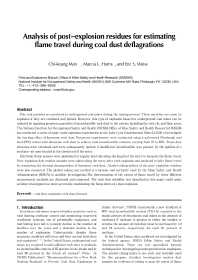Mining Publication: Analysis of Post-Explosion Residues for Estimating Flame Travel During Coal Dust Deflagrations
Original creation date: October 2011
Fine coal particles are produced in underground coal mines during the mining process. These particles can cause an explosion if they are entrained and ignited. However, this type of explosion hazard in underground coal mines can be reduced by applying generous quantities of incombustible rock dust to the entries, including the roof, rib, and floor areas. The National Institute for Occupational Safety and Health (NIOSH) has conducted a series of large-scale explosion experiments at the Lake Lynn Experimental Mine (LLEM) to investigate the inerting effect of limestone rock dust. Numerous experiments were conducted using a pulverized Pittsburgh coal dust (PPC) mixed with limestone rock dust to achieve total incombustible contents varying from 67 to 82%. These dust mixtures were entrained and were subsequently ignited, if insufficient incombustible was present, by the ignition of a methane-air zone located at the closed end of the entry. Electronic flame sensors were positioned at regular intervals along the length of the entry to measure the flame travel. Post-explosion dust residue samples were taken along the entry after each explosion and analyzed to infer flame travel by measuring the thermal decomposition of limestone rock dust. Alcohol coking indices of the post-explosion residues were also measured. The alcohol coking test method is a forensic tool currently used by the Mine Safety and Health Administration (MSHA) in accident investigations.The determination of the extent of flame travel by these different measurement methods are discussed and compared. The rock dust solubility test described in this paper could assist accident investigators in more accurately establishing the flame limits of a dust explosion.
Authors: C Man, ML Harris, ES Weiss
Peer Reviewed Journal Article - October 2011
NIOSHTIC2 Number: 20040046
Sci Technol Energ Mater 2011 Oct-Nov; 72(5):136-140
See Also
- Coal Dust Explosibility Meter Evaluation and Recommendations for Application
- Determining Flame Travel Measurements from Experimental Coal Dust Explosions
- Evaluation of the Bagged Stone Dust Barrier Effectiveness in a Bord and Pillar Mine
- Fire Detection
- Impact of Air Velocity on the Detection of Fires in Conveyor Belt Haulageways
- In-Mine Evaluation of Smart Mine Fire Sensor
- Real-time method to characterize a mine fire using atmospheric monitoring systems and MFIRE 3.0
- Refuge Chamber Expectations Training - 1.0
- Technology News 497 - "You Are My Sunshine": A New Video Release From NIOSH on the Sunshine Mine Fire
- Technology News 549 - MFIRE 3.0 - NIOSH Brings MFIRE into 21st Century
- Content source: National Institute for Occupational Safety and Health, Mining Program


 ShareCompartir
ShareCompartir
